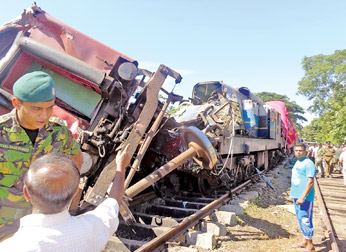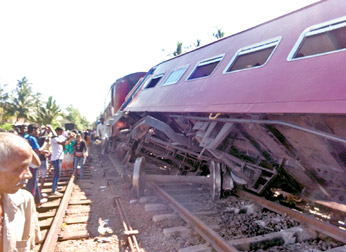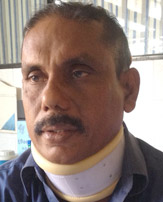|
Pothuhera train mishap :
Who is at fault?
By Kurulu Kariyakarawana
Sri Lanka Railways (SLR)or formerly known as the Ceylon Government
Railway was the prime mode of transport since its inception in 1858.
With 310 trains operating including 45 long distance and 12 intercity,
the SLR transports nearly 300, 000 commuters a day on the 1, 429
kilometre long- tracks spread throughout the country.
 |
| The ill-fated
train |
 |
| The halted
train almost turned turtle on impact |
 |
With an estimated revenue of over Rs.4.2 billion a year, public
expectations of a safe journey should be high but is it really so?
Although there was right royal awe for this heavy mode of transport
during the colonial period and even in latter times, the present
attitude is rather poor. The reason for this can be attributed to the
inconvenience faced by commuters on the one hand because of the less
number of trains and the large mass of humanity that patronises the
train service travelling daily to and fro to work and back in packed
compartments like sardines. On the other hand, the constant unexpected
delays which lead to late arrival at work places as well as the numerous
strikes called for by trade unions has caused a disgusting impression
among the public towards this once trusted service.
However, creating the latest fear on top of all these shortcomings is
that the department is fast losing credibility of rendering a safe and
sound journey to commuters with the recent mishap which left several
dozen commuters injured and some critically. Although accidents could
happen anywhere and at any moment, the modus operandi of the railway
authorities in trying to cover up its faults by passing the buck is
indeed appalling. Whether its a signal error and a technical error of
communication or a disregard of specific operating guidelines of a train
or perhaps both, there is no bigger blunder than a train with a full
complement of passengers ramming head on onto another parked train. This
is is unforgivable to say the least.
All the high-ups including the General Manager Railways B A P
Ariyaratne led by Minister of Transport Kumara Welgama arrived at the
scene in next to no time and pledged an immediate impartial inquiry into
the case to investigate what went wrong.
As a result five people who were identified as being directly
responsible for the accident including the Station Master and the
Signalman of the Pothuhera Railway Station, the guard, the driver and
the assistant of the Deyata Kirula train were interdicted with immediate
effect. A four- member committee led by Additional General Manager
Operations, Nalaka Bandara was appointed on Thursday.
The committee convened on Friday and commenced investigations.
Statements of the Pothuhera Station Master and the Head Guard of the
Deyata Kirula Train gave statements.
The committee is yet to question the signalman, the train driver and
his assistant. The latter two are still being treated at the Kurunegala
and Colombo National Hospitals and are said to be in a critical
condition.
Meanwhile, there is suspicion about the absence of another vital '
character' who has to be on the train- the Under Guard who had not
reported to work over illness.
It is a serious violation of railway laws and regulations by not
deploying an Under Guard for the train and sending it on its journey.
According to the law any passenger train which has more than eight
compartments had to be deployed with two guards, the Head Guard at the
rear in the Last Van and the Under Guard in one of the two connecting
dummy engines.
A regular train has six compartments including the engine. Long
distance trains like the Deyata Kirula are coupled with two regular
trains which altogether has 12 carriages. Due to the length of these
coupled trains it is mandatory to deploy an Under Guard in the centre
who can have a better view of an approaching hazard and thus is able to
apply the brakes in the event some mishap is about to take place. Since
it is too long for the Head Guard to notice such danger at once from the
position where he is.
Controversy surrounds the statement made by many 'parties' of the
department that the damage and the number of casualties could have been
minimized or even averted if the Under Guard was on board to apply
brakes along with the Driver at the front applying brakes.
It would have reduced the huge impact rendered by the long train. But
to the surprise of many, this issue never surfaced or it was
deliberately swept under the carpet by the railway authorities, who
instead argue on the other issues like drivers failing to control the
speed of the train, a suspected fault in the signalling system and track
changing unit of the Pothuhera Station.The Sunday Observer learns that a
Deputy Operational Superintendent who was on duty on Wednesday morning
had permitted the Deyata Kirula train to proceed without an Under Guard
on board.
When investigated what triggered the officials to let a coupled
passenger train to proceed by not even replacing with another Guard, we
learnt that there is a severe dearth of Guards in the department at
present. Around 280 vacancies for both Guards and Under Guards had not
been fulfilled for many months and the train was operating against the
set guidelines for safety.
It is also learnt that the recruitment of more Guards had not been
successful as the guards who were already there are not happy because it
will be a loss on overtime hours. General Manager Railways B A P
Ariyaratne admitting the shortage of guards at present said if the
authorities are to abide by the laws set out by the Railways Ordinance,
then many trains will have to be cancelled everyday. It has become
practically impossible to deploy two guards on a train due to the
shortage of guards. Therefore, it is not only the Under Guard's
responsibility to control the situation but the Head Guard and the
driver who should be aware of any unexpected emergency.
Although stationed at the rear, the Head Guard too could control the
train and its speed from the rear by merely studying the landmarks of
the ground when approaching a station.
There is a specific speed that a train must maintain when approaching
a station, whether it is a slow train or an express one. Under normal
circumstances the speed limit for trains is 80 kilometres per hour,
whereas the Deyata Kirula and Yal Devi trains can exceed 100kmph after
Anuradhapura to maintain the time schedule. But all trains have to
reduce speed to 15kmph when approaching a station and in this instance
the speed it was travelling was excessive. Locomotives do possess a
Black Box like all air planes that could record the speed the train was
travelling at to the specific second. Initial investigations revealed
that the train that rammed into the parked Raja Rata Rejina train was
travelling at 55kmph, which is a high speed. Investigations are being
conducted as to why the train was travelling at such a high speed even
when approaching a station.
Train drivers have a different story.
|

The driver Ajith Rupasinghe |
The driver of the No 17 Deyata Kirula train, Ajith Rupasinghe who is
currently being treated at the National Hospital with serious injuries
to his head and neck said the effort they had to put to bring a train
that was already signalled to proceed, to a standstill within a very
short distance was immense.
With an experienced career of 23 years as a locomotive driver, this
was the first accident faced by Rupasinghe. With his assistant on the
left seat inside the engine, the train left Colombo at 6.50am and had to
pick up a batch of passengers from a train that had broken down on the
way. When they were approaching Pothuhera the first signal post had
approved to proceed which they did. But to their utter horror when the
station was within visible distance fter a sharp bend there was a train
parked on the same tracks. He applied the brakes but it was too late as
the train did not stop until they jumped out of their seats and rushed
to the rear of the engine to save their lives.
The train that crashed into the other train caused serious damage to
the front portion of the train and the driver and his assistant had a
narrow shave. Rupasinghe who is relieved that there is not a single
death in the accident was hesitant to comment much on the technical side
as there was an inquiry pending.
When the drivers are claiming that the signal was given to proceed,
the railway authorities at the Pothuhera station say that the signal had
not been approved for the oncoming train to pass. It is too early to
surmise and come to any conclusion as to what really led to the
unfortunate accident. Over thirty passengers still being treated at the
Kurunegala Hospital.
Sri Lanka Railways with a vision "To be the most sought after land
transport provider in Sri Lanka, providing unsurpassed value to our
stakeholders" and a with a mission of "Providing safe, reliable and
punctual rail transport service for both passenger and freight traffic,
economically and efficiently".
These are the slogans mouthed by the Railway Department but in
reality there is a yaw3ning gap between the operation of the trains and
these slogans. It is high time the Department considers that safety of
passengers was paramount and prevent such glaring blunders from taking
place. much on the safety of its commuters in the future leaving no room
for such blunders. |

